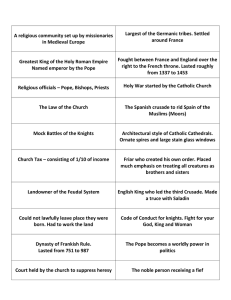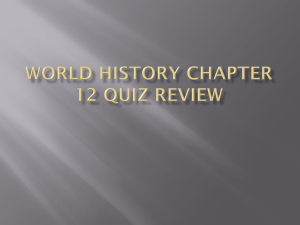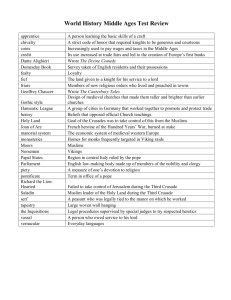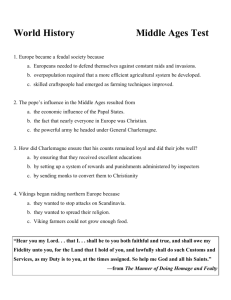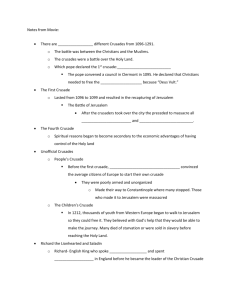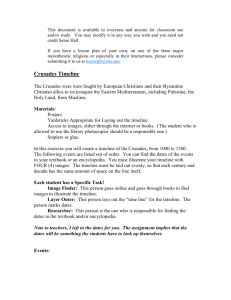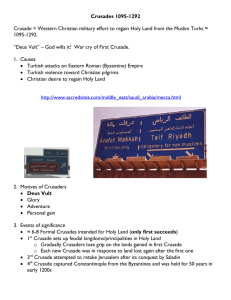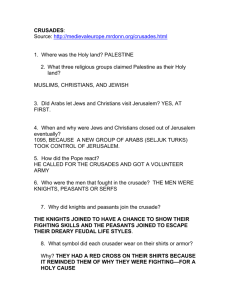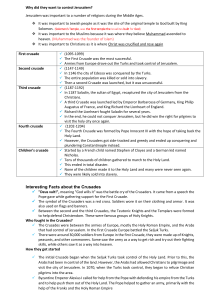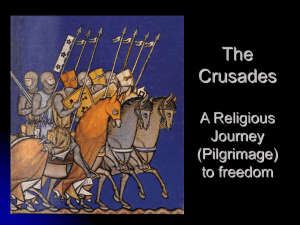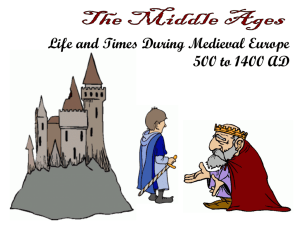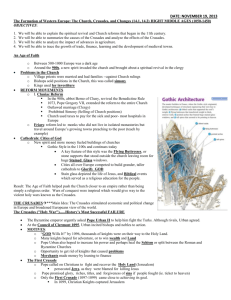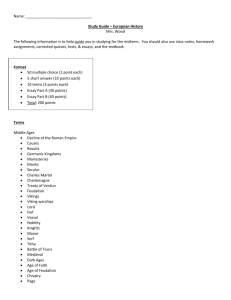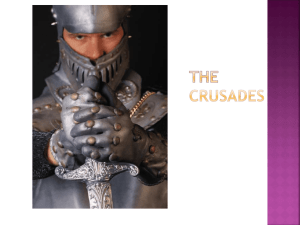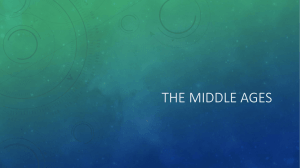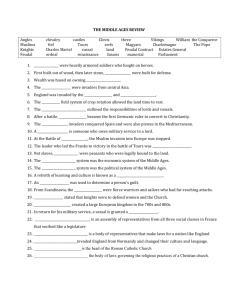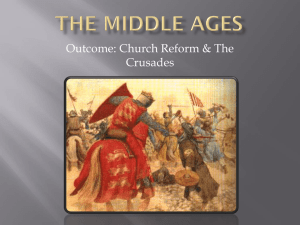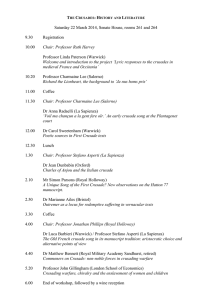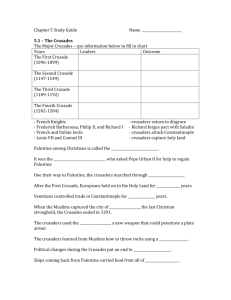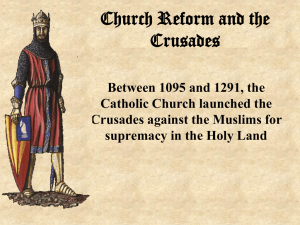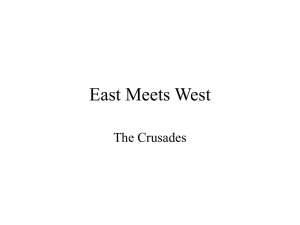Chapter 14 The High Middle Ages Review Test
advertisement
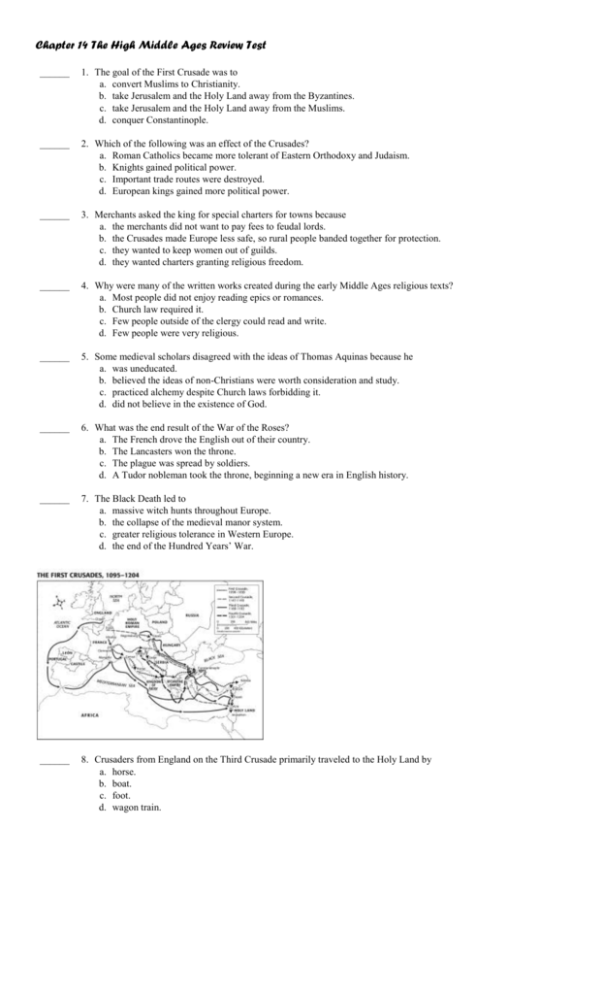
Chapter 14 The High Middle Ages Review Test ______ 1. The goal of the First Crusade was to a. convert Muslims to Christianity. b. take Jerusalem and the Holy Land away from the Byzantines. c. take Jerusalem and the Holy Land away from the Muslims. d. conquer Constantinople. ______ 2. Which of the following was an effect of the Crusades? a. Roman Catholics became more tolerant of Eastern Orthodoxy and Judaism. b. Knights gained political power. c. Important trade routes were destroyed. d. European kings gained more political power. ______ 3. Merchants asked the king for special charters for towns because a. the merchants did not want to pay fees to feudal lords. b. the Crusades made Europe less safe, so rural people banded together for protection. c. they wanted to keep women out of guilds. d. they wanted charters granting religious freedom. ______ 4. Why were many of the written works created during the early Middle Ages religious texts? a. Most people did not enjoy reading epics or romances. b. Church law required it. c. Few people outside of the clergy could read and write. d. Few people were very religious. ______ 5. Some medieval scholars disagreed with the ideas of Thomas Aquinas because he a. was uneducated. b. believed the ideas of non-Christians were worth consideration and study. c. practiced alchemy despite Church laws forbidding it. d. did not believe in the existence of God. ______ 6. What was the end result of the War of the Roses? a. The French drove the English out of their country. b. The Lancasters won the throne. c. The plague was spread by soldiers. d. A Tudor nobleman took the throne, beginning a new era in English history. ______ 7. The Black Death led to a. massive witch hunts throughout Europe. b. the collapse of the medieval manor system. c. greater religious tolerance in Western Europe. d. the end of the Hundred Years’ War. ______ 8. Crusaders from England on the Third Crusade primarily traveled to the Holy Land by a. horse. b. boat. c. foot. d. wagon train. ______ 9. The picture above shows an example of a. a medieval manor. b. illumination. c. a medieval guild. d. Gothic architecture. 10. The __________________________ Crusade was the only one in which the Crusaders achieved their goal. (Fourth/First) 11. The most important early trading city in Italy was __________________________. (Venice/Rome) 12. Europe’s first banks were created as the use of currency and __________________________ increased, especially at trade fairs. (bartering/credit) 13. The process of decorating a written manuscript with pictures or designs was called __________________________. (illumination/Gothic) 14. King Arthur and his knights of the Round Table adhered to the code of __________________________. (chivalry/heresy) 15. The __________________________ was a devastating plague that killed as many as one in three people in Europe. (Black Death/Crusade) ______ 16. Large woven wall hanging ______ 17. A person who had mastered the basics of a craft ______ 18. Muslim leader of the Holy Land during the Third Crusade ______ 19. Used by merchants to get consumer goods to customers ______ 20. A group of cities and towns in Germany that worked together to promote and protect trade ______ 21. Legal procedures supervised by special judges to try suspected heretics ______ 22. Wrote the Divine Comedy ______ 23. Called the Council of Clermont to ask knights and nobles to help the Byzantines against the Turks ______ 24. Changed the course of the Hundred Years’ War ______ 25. A person learning a trade with a skilled crafter a. Hanseatic League b. Joan of Arc c. Saladin d. trade fairs e. journeyman f. Pope Urban II g. Dante Alighieri h. the Inquisitions i. apprentice j. Tapestry
